If someone in your office were to succumb to cardiac arrest, would you be confident enough to use a life-saving defibrillator, would you know where to find one? Logicearth has created a free guide for you to share with your colleagues that takes the fear out using a defibrillator. This course shows you when and how to use a defib, so that if you had to, you could press the shock button with confidence.
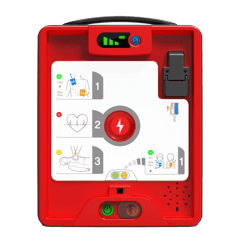 What is a defibrillator?
What is a defibrillator?
A defibrillator is a fully automatic medical device that delivers an electric shock to the heart. You use it to jolt the heart out of an abnormal, chaotic electrical rhythm and allows the normal heart rhythm to restart.
Examples of automated external defibrillators

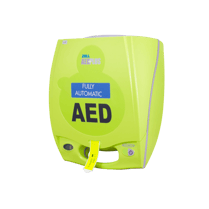
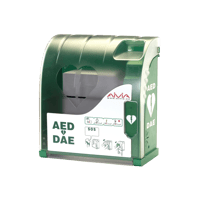
What are the signs and symptoms of sudden cardiac arrest?
An AED is designed to treat someone who has suffered a sudden cardiac arrest. This normally affects older people, but it can happen to anyone, anywhere, at any time.
- Unconscious
- Unresponsive
- Not breathing or
- breathing erratically
- Heart's normal electrical impulses become chaotic and disorganised
(called ventricular fibrillation or VF) - Heart quivers
- Heart stops pumping blood around body
Heart attack vs cardiac arrest
People often use the terms cardiac arrest and heart attack interchangeably, but they are actually two different events. Put simply, a cardiac arrest is an electrical problem, whereas a heart attack is a circulatory problem.
According to the British Heart Foundation, 'a heart attack is when one of the coronary arteries becomes blocked. The heart muscle is robbed of its vital blood supply and, if left untreated, will begin to die because it is not getting enough oxygen.
A cardiac arrest is when a person’s heart stops pumping blood around their body and they stop breathing normally.
Many cardiac arrests in adults happen because of a heart attack. This is because a person who is having a heart attack may develop a dangerous heart rhythm, which can cause a cardiac arrest.
A heart attack and a cardiac arrest are both emergency situations. Call 999 straight away.'




If someone is having a heart attack, the British Heart Foundation recommend the following steps:
- Step 1: Shake the person and shout to them - are they responding?
- Step 2: Check for normal breathing
- Step 3: Call 999
- Step 4: Start CPR - Give 30 chest compressions
- Step 5: Give two rescue breaths
- Step 6: Continue CPR until an ambulance arrives
If someone is in cardiac arrest, you need to locate the nearest defibrillator.
Where can i find an AED?
The emergency services may be able to tell you over the phone where the nearest AED is located. AEDs are usually located in public places such as: shopping centres, transport hubs, gyms, sports clubs, leisure centres.
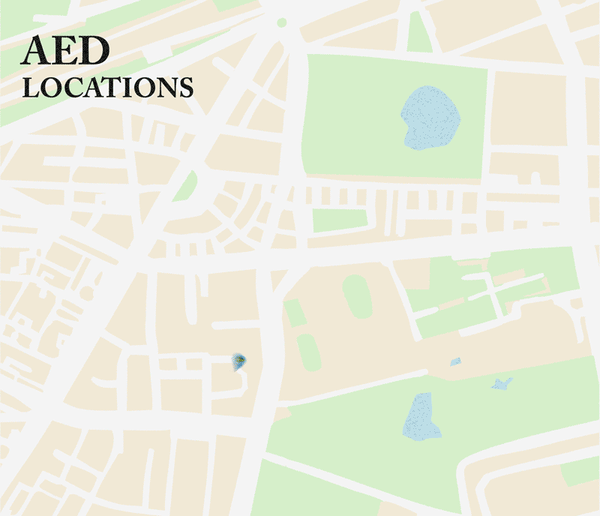
Your nearest AED may be locked in a cabinet for security reasons, but don't panic – there will be visible instructions on how to gain access, for example using a keypad code.
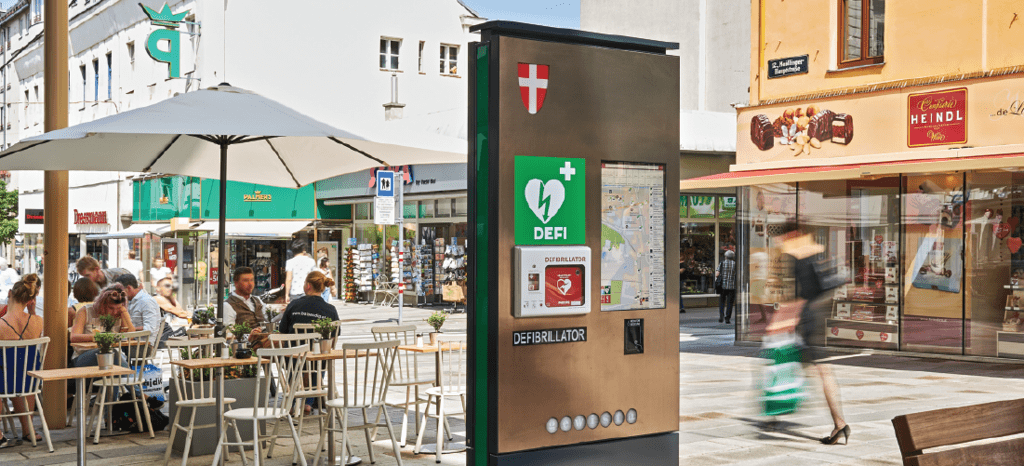
Examples of AED signage
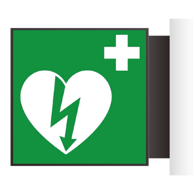

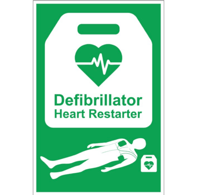
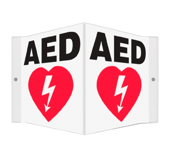
How do you use an AED?
AEDs were designed for saving lives and to be used by anybody – no training is required. Each AED gives verbal instructions and visual prompts on how to use it, so everything is explained for you, step by step.
When do you use an AED?
It’s only rarely that the emergency services arrive on the scene early enough to carry out defibrillation. For this reason, it’s vital that as many people as possible are able to find and use an AED. Knowing how to do this means that you could provide the crucial link in the chain of survival.
What would you do if someone collapsed in front of you?
If someone collapses near you in a public place and shows the signs of sudden cardiac arrest – take action, be a link in the CHAIN!
C-H-A-IN
- Call 999/112
- Hands on heart: Cardiopulmonary resuscitation (CPR)
- AED
- INcreased chance of survival

Available to download in our Resources section below.
These steps are often represented as the chain of survival, because they are a sequence of basic actions that can save the life of a person in sudden cardiac arrest. A handy way to remember these steps is using the letters in the word 'chain'.
For more on effective CPR, see our Useful links section.
Defibrillation Taboos & FAQs
Here are some of the questions that we might be too embarrassed to ask:
What if it's wet – can you use an AED in those conditions?
Yes, as long as you make sure the casualty's chest is dry before attaching the electrode pads. Wipe any sweat from the chest, as moisture could direct the current away from the heart. If the electrode pads are not stuck to the person correctly, then the defibrillation won't work.
Is it okay to use an AED on a child casualty?
Only if you use paediatric pads, since these deliver a lower voltage charge. Many AEDs come equipped with two sets of electrode defibrillator pads – one for adults and one for children.
Can you use an AED if the casualty is a pregnant woman?
Yes, you can and should use an AED on this type of casualty.
Can you use an AED on a person who has a pacemaker fitted?
Yes, you can use an AED on this type of casualty.
Could you get sued for using an AED without the casualty's permission?
The law is on your side – you should not be afraid of any legal repercussions from using an AED. In many countries, there's 'Good Samaritan' legislation that protects those who help people in a medical emergency.
Authorities and organisations in many areas are increasingly making efforts to map all locations of public access defibrillators. The best first step is to contact your local ambulance service for more information.
Remember
It’s the first 3–5 minutes that count…
You can only help the situation by using an AED – you’ve nothing to lose.
What do defibrillators do?
A common misconception is that a defibrillator restarts a heart that has stopped, but this is not the case. If the heart can no longer create its own electrical pulse, using a defibrillator will not work. The defibrillator does what the name implies – it defibrillates a fibrillating heart.
How do defibrillators work?
They deliver a shock essentially resetting the heart, potentially enabling it to regain normal electrical activity and, therefore, a normal rhythm. If the shock is not strong enough, the heart might not completely repolarise, leading to a continuation of arrhythmia. The defibrillator will monitor the new heartbeat and advise the user to shock again (if required).
Downloadable resources
Course
Please click here to download and share this free course in html to host on your website, or get the files and add it to your LMS.
Poster
https://courses.logicearth.com/defearthedefib/course/en/assets/5b8fc56585f9bd122439777b/file.pdf
Chain poster
https://courses.logicearth.com/defearthedefib/course/en/assets/5c938862f7fa1d41ed289d0b/file.pdf
Interested in hearing more about our course development services? Contact Logicearth today.
Useful links
UK
National Ambulance Service Medical Directors Group – Association of Ambulance Chief Executives
British Cardiovascular Society
British Heart Foundation – Northern Ireland*
Northern Ireland Ambulance Service
Northern Ireland Chest Heart & Stroke*
Northern Ireland Fire & Rescue Service
Irish
European
European Resuscitation Council
European Society of Cardiology
American
InterAmerican Heart Foundation*
International
International Liaison Committee on Resuscitation
Academic
University of Warwick study on use of AEDs
* These also provide further online training on first aid









Was this article helpful?